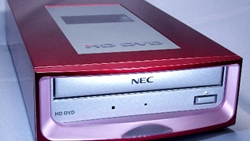JVC develops Blu-ray/DVD combo ROM; NEC advances HD-DVD format

NEC's single-optical-head prototype HD-DVD, DVD and CD recorder features a three-wavelength-compatible optical head.
The jockeying for position in the developing HD disc format war has continued with important hardware and marketing developments over the past few weeks.
On Dec. 24, JVC announced the development of a combination Blu-ray/DVD ROM disc technology that relies on two laser heads – a blue wavelength laser (405nm) and red wavelength laser (650nm)- to read data from two separate layers on the newly developed ROM disc.
JVC developed a ROM with two data layers to support the new technology. Beneath a protective layer sits a reflective film that reflects the blue laser but is transparent to the red laser.
Deeper on the disc is a dual-layer structure - the standard for commercially released DVD material. The first layer is made of a reflective material that’s semi-transparent to the red laser. Below is a red-laser reflective film material.
The disc stores 25GB of Blu-ray material on its outer layer and 8.5GB of SD DVD video programming on its inner layers. The dual-format ROM disc allows studios to release HD and SD material on the same discs. Consumers with HD displays and Blu-ray players will be able to enjoy HD programs recorded on the disc. Those with SD systems will be able to enjoy the SD version recorded on the DVD layer and watch the HD version after upgrading their home entertainment systems with a Blu-ray disc player and HD display.
The company plans to submit a proposal to the Blu-ray Disc Association for acceptance as a specification for a future commercial release. It’s also working on a combo ROM design with 58.5GB storage capacity.
The professional video industry's #1 source for news, trends and product and tech information. Sign up below.
Across the field of battle in the HD-DVD camp, NEC announced last month that it has developed a single-optical-head prototype HD-DVD, DVD and CD recorder in a PC-drive form factor. The drive features four significant attributes: a three-wavelength-compatible optical head; large scale integration to overcome the physical differences among the three formats; compact integration of components into a form factor suitable for desktop computer integration; and stable operation.
The prototype demonstrates the feasibility of supporting entrenched optical formats while at the same time accommodating what is likely to be a burgeoning demand for high-definition recording on the desktop and in home entertainment settings.
In late December, Toshiba, NEC, Sanyo and Memory Tech formed the HD-DVD Promotion Group. The group will promote the HD-DVD format and encourage content and hardware development for the format.
For more information, visit www.nec.com and www.jvc.co.jp/english/press/2004/bd-dvd.html.
